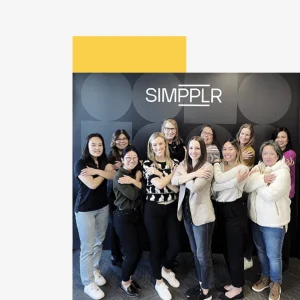Ten things I love about me: How bragging about yourself – in the nicest way possible, of course – enhances work-life harmony and leads you to your vein of gold within. Join us on this Cohesion podcast with Marla J Albertie, owner and founder of a multi-media coaching company, as we talk to her about her recently re-released work-life harmony journal. We also discuss work-life integration and company culture, industrial and organizational psychology for teenagers, what’s gone wrong with DE & I initiatives, and whether modern leadership is rocket science.
Working nine to five
Marla’s book ‘The Ultimate Brag Book About Yourself: A Hundred Questions About How Awesome You Are’, is created for the nine-to-five working woman who’s searching for work-life harmony. Women don’t always find value in themselves, Marla tells us. They struggle to locate the goodness and greatness inside. The book is filled with fun questions and space to record your own ideas, and has absolutely nothing to do with conceit. It allows you to identify the stuff you like, express your ambitions and enjoy yourself.
“I want people to see their own value and realize that yes, you matter. You don’t have to wait for the world to tell you that what you want matters.”
Looking at this in a professional context, not everyone’s a fan of affirmations. But, if we take job interviews as an example, we can see the exercise is – or should be – a two-way street. It’s not only about a prospective employer asking all the questions. The job applicant has questions too and needs to have the confidence to list what they want, need and like, alongside interest and expertise. Marla stresses this isn’t about people striving for perfection, but about the realization of your value. If you can’t see the value you’re bringing to the interview, how can anyone else see it?
Over many years of coaching, Marla found that women are particularly bad at celebrating the value within themselves, or ‘bragging’. This is likely because of the traditional mindset going way back to when women were seen as bearers of children, and carers. Culture still carries this mindset, and leaves women feeling that if they can’t give 100% to something, they’ve failed. Men, on the other hand, generally speaking, will feel confident about the 20% they can give, and develop from there. Add to that the superwoman schema, attributed to the African-American woman. We’re the caretakers, we’re strong, we’re qualified, and added to that we have to be on top of it all.
“African American women are the highest educated group of individuals in the country, yet we’re the lowest. We’re at the bottom of the pile when it comes to work and pay, right along with other minorities.”
Considering this extra pressure, Marla asks, why would a woman brag about herself? She’s got so much going on and no time to think about the good things she does. She’s too busy trying to make sure she gets this or that certification so they see and hear her at the table, and don’t talk over her.
Although the journal is aimed at women, it’s great for men too, and plenty of men have bought the book. It’s meant to bring some joy and fulfillment, and get you to answer questions you never thought you’d be asked. Think out of the box, and have fun. Do it alone, with a partner, a friend, however you want.
The mindset to do great things
Marla knew from an early age she wanted to teach and educate, and alongside that came the realization that we all have to work for money. Understanding that teachers didn’t earn a lot, she decided to become the first black female architect, and meanwhile ran some little businesses on the side, even from the sixth grade. And so, her mindset to do great things developed in parallel with a strong work ethic instilled by her parents, her entrepreneurial flair, and a desire to achieve on her own terms.
“When I’m coaching, I throw out the challenge of what a person can do, as opposed to what they can’t. You can’t do 30 minutes of XYZ? Can you do 10? It’s not 30, but it’s also not zero. Can you do that? It’s so much about mindset, about focusing on what you can do.”
Industrial organizational psychology consulting for teenagers
That’s the study of human workplace behavior to you and me, but for teenagers. Marla is currently completing a Ph.D. in Industrial Organizational (IO) Psychology, which is how – along with her passion for helping people grow and develop – she founded her global nonprofit I/O for Teens Inc. Most kids leave school without the crucial IO skill sets necessary for survival at the start of a career, without any knowledge of workplace behavior or what to expect, or to express what they want or need. Marla saw the gap and created a solution. Through her programs, teens in 8th through 12th grade can leave school prepared for the world of work, with the right expectations and boundaries in place.

We also have a community fund and a scholarship fund, Marla says, but we’re not here to force kids to go to school, not at all. We emphasize that, whether you go to school or not, you’re still going to have to work with people at some stage of your life, and that’s where we can help and inspire. Getting these teens to discover their dreams, chase them and live up to their own potential is what we do. Kids love it so much because they’re being asked what they actually want.
“They’re not asked that question in schools. We’re asking them to think about the future, about their careers, what it’s going to take, or what they need to get where they want to go.”
Truth speaks
Brag book aside, Marla, the work-life harmonizer, coaches, consults and trains working women by helping creating strategies and solutions for work-life integration.
“The reason I call myself the work-life harmonizer is because, really, there’s no such thing as balance. When you balance something, you’re aiming for perfection so that doesn’t work. You have to learn to harmonize, to integrate your life with your work and vice versa.”
We start each coaching session with a reminder that we are, first and foremost, a human being, she says. Before we consider whether we’re male or female, or however we identify, we are all human beings. From there, we separate into gender, into who’s a spouse, a parent, a partner, and so on. This is because leaders don’t always realize they’re dealing with human beings. Eyes on the bottom line, they tend to forget this human has suffered a family tragedy and might not be in a healthy emotional state even though they’ve had a whole two days off. That’s not the right approach to harmonize life and work.
“Leadership plays a huge part in being able to harmonize your life because it’s all about boundaries. Really, this is what harmonization is.”
Marla poses the question “Where are you on your own calendar?” You need to block time for you, so you can do what you need to do for yourself. This is reasonable, and legal. Find a place to say no, a day you can leave at five to get to your son’s baseball game, or go and have your nails done. Harmonize your life and work in other words.
Leader, I’m watching you
Marla has her fingers on the pulse of the modern workspace, and looking at where we’re at post-Covid-19 pandemic, we asked her what’s going wrong with the establishment of good cultures at work.
Culture starts right at the top, with good leadership, she reminds us. Also, we should bear in mind that the word ‘culture’ has its roots in the word ‘cult’, and a cult is a collective way of doing things a certain way. If a newbie arrives and shakes things up a bit, there will be problems in the cult. But this isn’t how a progressive leader views things, because a good leader welcomes new ideas and has the capacity to think differently.
Whatever the leader is doing, whatever their mindset, this will trickle down through an organization and feed the culture. Never forget, Marla says, that a leader is always being watched by people on every organizational level. What they do, what they say, their attitudes and approaches, and even what they wear, or how their hair looks, will be taken on board as an expression of the culture.
A good leader will always pay attention to shifting trends. We used to go into the office to work, but the Covid-19 pandemic arrived and changed all that. We worked from home. Nowadays, some of us want to keep on doing this, some not, and some want a bit of both, or a hybrid situation. A good reader needs to be ready to shift the culture to suit changing trends like these. It’s vital to remember to fit the culture to the people, not the other way around.
“You hire people because you have a problem that needs solving, so don’t look at the outside of that person and worry about them fitting the culture. Stop looking at the nose ring, or the hair, and concentrate on the value they can bring.”

DE&I is not a trend
We asked Marla if Diversity, Equity and Inclusion (DE&I) has had its day, because it seems like some sectors have stopped pushing for change and the importance of the initiative has been forgotten.
She reminds that DE&I has been around for decades and certainly isn’t a trend. Companies were inspired by the movement toward DE&I and made big efforts to implement it. Some hired Chief Diversity Officers, some developed whole DE&I departments, and much money was spent. This is all great, but there has to be action, there has to be education and support for people who are resistant to DE&I because they have an incomplete idea of its value, and even what it is, exactly.
Leadership must be fully on board with DE&I initiatives, want them, and be compassionate. If they haven’t got the skills to sustain an effective program, then they must hire the right people, give them full autonomy, and learn. Leaders must be brave enough to stand up to what they don’t like, and have those scary conversations.
“You know, Martin Luther King is probably turning over in his grave because we’re still dealing with this mess in 2023.”
Marla concludes that DE&I is a rich and complex issue. It’s not a box to be checked to make your company culture look okay. Do something about DE&I in your company, do it properly and keep doing it.
Leadership is not rocket science
Marla is working on a new book called ‘Leadership is Not Rocket Science. 10 Strategies to Be the Best Leader you can Be’.
“The number one component for leadership is people. Because, you being able to call yourself a leader means people have to be following you. So, if no one’s following you, who are you leading?”
Show interest in your colleagues. Ask them a bit about their lives, exchange ideas and snippets of news – we’re not talking about life stories here. In my experience, most people don’t do this. If you do this, they will do this because people behave the way they are treated – and this is what IO psychology is all about. Take time to find out, learn, and consider changes that will make life better for employees.
Think about how workers were sent home when the Covid-19 pandemic struck. WFH was thrust on millions of people who didn’t know how to do it, but they adapted and coped, and most experienced difficulties. Now, we’ve told them to come back into the office. Stop and think about that for a moment. Think about a more flexible work schedule to benefit your people, and ease them into that. Get feedback by asking for their opinion on flexibility.
Try not to always think about the bottom line. This can be tricky with a vast office block standing empty while employees show reluctance to return, but is there a way you can re-purpose that space? Sublet it, or sell some of it and invest, say, in better WFH equipment for your employees? You might lose money in the short term, but will it pay off better going into the future?
A business has to make money, for sure, but without people, you’ll have no business. Truly, it pays to think about ways to invest in your people and offer them the most robust employee experience possible. This is important because those IO teens we spoke about earlier, generation Z, are going to – are already – demanding a complete employee experience and know exactly where they’ll work and where they won’t.
For HR people listening to, or reading, this, Marla urges leaders to lead by example. Respect your employees, know even just a bit about their lives, the work they do, and the department they’re in. If you want to improve employee experience, ask. Ask everyone, not just a focus group. Get feedback, and consider all suggestions however crazy. Put your people first.
“I’ve done the research. Any organization can run this way, putting their people first. Put your people first, invest in them, then go look at your profits.”
If you’d like to find out more, you can listen to the full podcast here. Marla is on LinkedIn, and you can also visit her website for information on her coaching consultations and more, and follow on Instagram. You can visit her IO for Teens non-profit organization website, and please donate to this project if you are able. Marla is grateful for any amount because they need all the help they can get to support and inspire teens all over the world. You can also follow and support the IO for Teens initiative on Instagram.
Marla is happy for readers and listeners to get in touch with her by email at contact@truespeechcoaching.com.
“Let’s change this world one person at a time, because it can happen.”
Please don’t forget to share this podcast. You can subscribe to the Simpplr Cohesion Podcasts here.

















